Katrina Relief
I went onsite to assist the Americas Red Cross with communication in the Katrina relief effort. Our team was the first one dispatched from the Montgomery ARC operations HQ into the disaster zone. So much has been said about Katrina that I'll not rehash the subject.
I will share one glimpse of how our efforts helped. My good friend W4JO had joined us in MS, and was dispatched to Vancleave high School. Since many signs were down making it hard to find things, I drove out to the shelter, with James following. Once there, I looped through the parking lot, and headed back to my assigned station. As I was leaving the parking lot, I noticed the shelter manager running across the lot waving & yelling. Once I rolled my window down, I realized she was yelling "don't leave, we still need you!". We chatted, and I explained that the Amateur radio operators would stay as long as they needed us. She was very thankful, and said: "You have to understand, until you guys got here, we were completely alone. We had no idea if the world knew we were here, and no way get help. Our phones still don't work, and the link you provide to HQ is critical for us".
This really put things in perspective for me. Several of us were slightly disillusioned at the time due to personality issues in some of the local amateur leadership positions, the lack of interest/capability of using more advanced technologies like HF/Pactor/email, lot's of "hurry up & wait", etc. On the whole, the amateurs sent into the zone were not utilized as effectively as we could have been. But when you get down to it, when there are no communications available at all, even a very basic capability like simplex 2m nets are invaluable, and in coastal Missippi that September, really added value to a difficult situation.
|
- Hurricane Katrina hit the Gulf Coast very hard. These photo's are in Ocean Springs near Gulfport MS just a block from the Red Cross operations center.
- Photo's do not really capture the effect of the storm surge. This used to be a concrete block home.
- The storm surge in some areas was measured at 23' with another 8-10' of waves on top of that
|
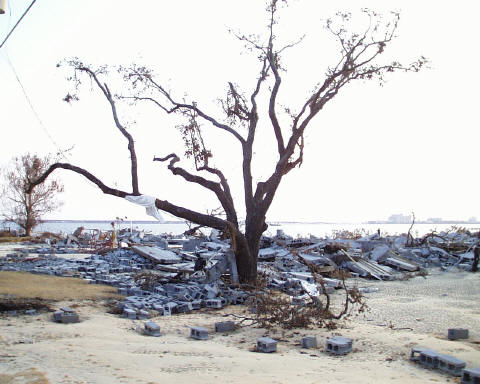
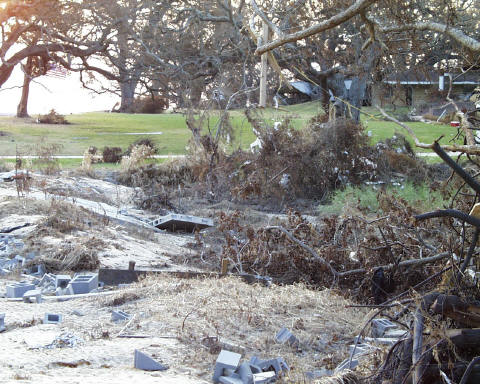
(Click on the photo's to enlarge)
|
- This used to be a house. All that is left is the front porch, steps, and some toys (I did not pose the bear, it was just sitting there this way)
|
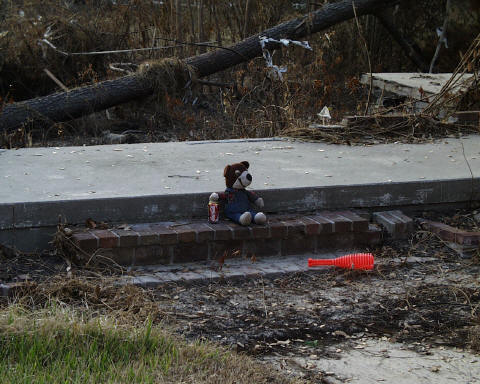 |
| Here are some photo's of storm surge damage:
      
|
- Brookhaven MS was on one of the major evacuation routes from LA. It was our first stop in our relief efforts.
- This is the temporary Red Cross HQ in the city. They had no communications, so the first step was to deploy the disaster radio kits we brought from Montgomery.
- In this photo we are leveling the antenna on the roof. The radio and coax was just inside the window.
|
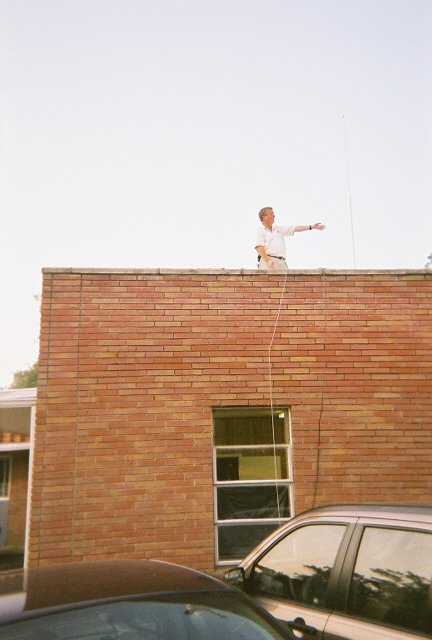 |
- Makeshift antenna mast made from semi-trailer spreader bars, a tripod from landscape timbers and some boy-scout lashings to get the Brookhaven Red Cross logistics warehouse on the air. It worked!
- Mike AB0VM and Robin KA5QDL steady the tripod while Alan KM4BA helps lash the mast in place
|
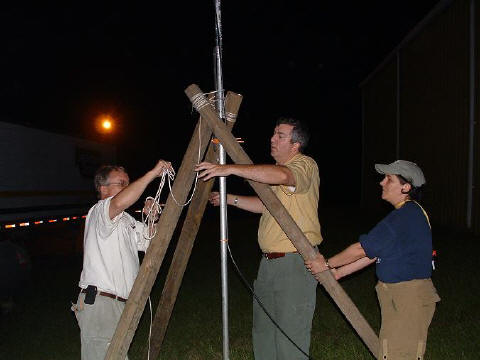 |
| |
|
- Tuesday AM in Brookhaven, I'm about to start roaming the county testing the range of the Red Cross radios
- The RC staffer with his back to us was from NJ. Nearly all the RC staff was from other states, with heavy representation from DC as well. He was asking about my HF antenna just to the right of his elbow.
- This is my third day on the road, 2nd without a shower. Baby wipe baths were the best approach, if showers were available they were heavily used. (as in all day long, in 15 minute increments). About day 4 I decided to wash my hair over a sink, but kept the water out of my eyes and mouth.
|
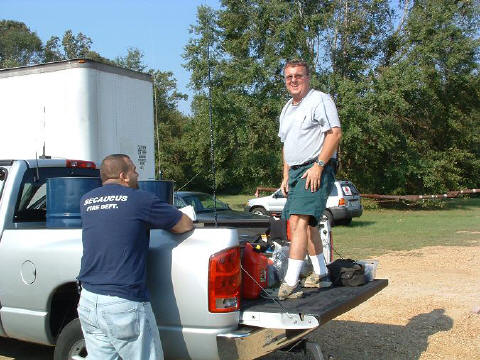 |
- This is the Vancleave High School MS Red Cross shelter with some of the staff. Vancleave and other small towns slightly north of the coast had both local residents and evacuees from the coast.
- This shelter had about 200 clients, which does not seem like much, but is quite a bit of people to be living in hallways
- My truck is loaded with MRE's and water to distribute to the RC staff shelters. While there was a shortage of MRE's at first, as the disaster kitchens came online there were MRE's everywhere, to the point that they had to be moved to make space.
- The military had pallets of MRE's, water and ice in mall parking lots which were handed out to anyone who stopped. Requests went out on the local radio stations to please take some MRE's so the trucks could go home! It's safe to say that all involved were tired of MRE's at the end of the week.
|
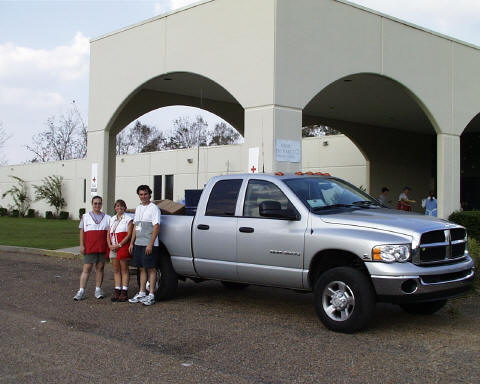 |
- This was our antenna farm at Vancleave High School shelter. We had 2m J-pole in the tree on the right and a multi-band HF Dipole even higher.
- Our operation was just in side the doors
- The shelters had police or National Guard security 24x7, so we did not have any problems with theft. (I'd have been an easy target with the truck bed full of supplies and equipment)
|
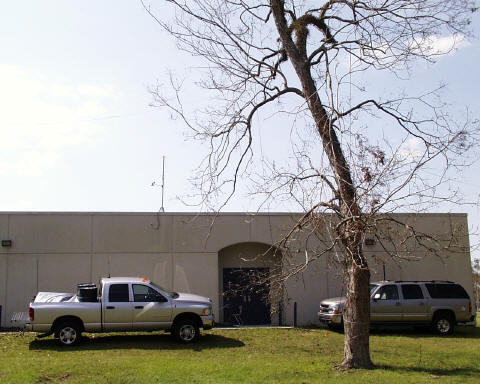 |
- Here's Jim W4JO at the radio desk for the Vancleave shelter. Most ops were on two meters (VHF) FM simplex, but we also used HF radio for longer range communications
- The radio was manned 12-14 hours a day, and monitored at night
- We slept in cots just to the right of the desk
- The teacher whose classroom was just past our desk invited me in to see photo's of her house. I expected damage, but all that was left was the driveway. It was 1/2 mile in from the coast, 13' above sea level, and on 10' concrete pilings!
- The Purell hand sanitizer is notable..... we used it non-stop to minimize risk of contagious disease. The shelters were very prone to outbreaks due to the crowded conditions and sanitation issues. All worked very hard to keep things clean and sanitized!
|
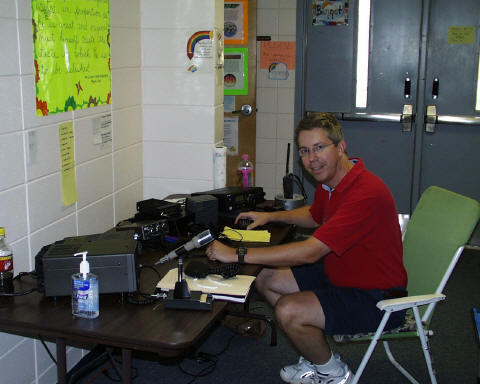 |
- Fuel was very hard to find, so I left Atlanta with 175 gallons of diesel. This gave me more than a 3500 mile range! As I did not know where I would be sent it was a significant relief not to depend on local fuel availability. While I did not need all the fuel, supply was limited and expensive during the first part of our trip.
- Here I use a self-starting siphon hose to refuel with Bio-diesel (non-polluting to boot!)
- Unlike Gas, diesel can be carried safely. The drums contain a slightly processed vegetable oil, not that different from cooking oil
- You can see three of the antennas on my truck: VHF/UHF dual band amateur (roof), Red Cross 47 Mhz (barrell), and cellular. I also had an HF antenna for long range comms on the rear of the bed.
|
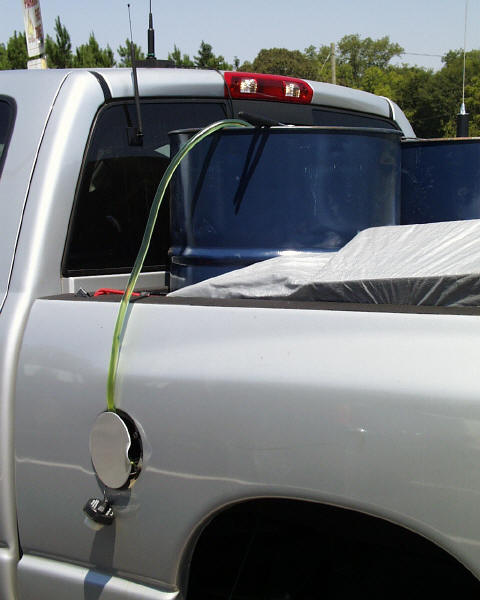 |
















